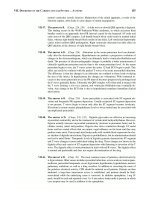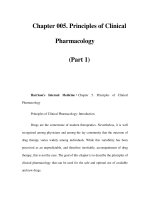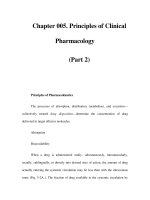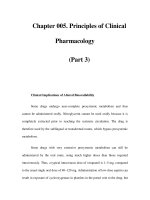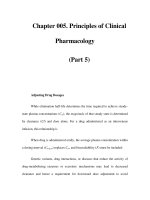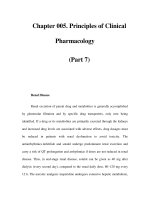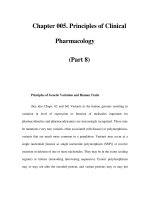Chapter 005. Principles of Clinical Pharmacology (Part 5) doc
Bạn đang xem bản rút gọn của tài liệu. Xem và tải ngay bản đầy đủ của tài liệu tại đây (16.16 KB, 6 trang )
Chapter 005. Principles of Clinical
Pharmacology
(Part 5)
Adjusting Drug Dosages
While elimination half-life determines the time required to achieve steady-
state plasma concentrations (C
ss
), the magnitude of that steady state is determined
by clearance (Cl) and dose alone. For a drug administered as an intravenous
infusion, this relationship is
When drug is administered orally, the average plasma concentration within
a dosing interval (C
avg,ss
) replaces C
ss
, and bioavailability (F) must be included:
Genetic variants, drug interactions, or diseases that reduce the activity of
drug-metabolizing enzymes or excretory mechanisms may lead to decreased
clearance and hence a requirement for downward dose adjustment to avoid
toxicity. Conversely, some drug interactions and genetic variants increase CYP
expression, and hence increased drug dosage may be necessary to maintain a
therapeutic effect.
The Concept of High-Risk Pharmacokinetics
When drugs utilize a single pathway exclusively for elimination, any
condition that inhibits that pathway (be it disease-related, genetic, or due to a drug
interaction) can lead to dramatic changes in drug concentrations and thus increase
the risk of concentration-related drug toxicity. For example, administration of
drugs that inhibit P-glycoprotein reduces digoxin clearance, since P-glycoprotein
is the major mediator of digoxin elimination; the risk of digoxin toxicity is high
with this drug interaction unless digoxin dosages are reduced. Conversely, when
drugs undergo elimination by multiple drug metabolizing or excretory pathways,
absence of one pathway (due to a genetic variant or drug interaction) is much less
likely to have a large impact on drug concentrations or drug actions.
Active Drug Metabolites
From an evolutionary point of view, drug metabolism probably developed
as a defense against noxious xenobiotics (foreign substances, e.g., from plants) to
which our ancestors inadvertently exposed themselves. The organization of the
drug uptake and efflux pumps and the location of drug metabolism in the intestine
and liver prior to drug entry to the systemic circulation (Fig. 5-3) support this idea
of a primitive protective function.
However, drug metabolites are not necessarily pharmacologically inactive.
Metabolites may produce effects similar to, overlapping with, or distinct from
those of the parent drug. For example, N-acetylprocainamide (NAPA) is a major
metabolite of the antiarrhythmic procainamide. While it exerts antiarrhythmic
effects, its electrophysiologic properties differ from those of the parent drug.
Indeed, NAPA accumulation is the usual explanation for marked QT prolongation
and torsades des pointes ventricular tachycardia (Chap. 226) during therapy with
procainamide. Thus, the common laboratory practice of adding procainamide to
NAPA concentrations to estimate a total therapeutic effect is inappropriate.
Prodrugs are inactive compounds that require metabolism to generate active
metabolites that mediate the drug effects. Examples include many angiotensin-
converting enzyme (ACE) inhibitors, the angiotensin receptor blocker losartan, the
antineoplastic irinotecan, and the analgesic codeine (whose active metabolite
morphine probably underlies the opioid effect during codeine administration).
Drug metabolism has also been implicated in bioactivation of procarcinogens and
in generation of reactive metabolites that mediate certain adverse drug effects
(e.g., acetaminophen hepatotoxicity, discussed below).
Principles of Pharmacodynamics
Once a drug accesses a molecular site of action, it alters the function of that
molecular target, with the ultimate result of a drug effect that the patient or
physician can perceive. For drugs used in the urgent treatment of acute symptoms,
little or no delay is anticipated (or desired) between the drug-target interaction and
the development of a clinical effect. Examples of such acute situations include
vascular thrombosis, shock, malignant hypertension, or status epilepticus.
For many conditions, however, the indication for therapy is less urgent, and
a delay between the interaction of a drug with its pharmacologic target(s) and a
clinical effect is common. Pharmacokinetic mechanisms that can contribute to
such a delay include uptake into peripheral compartments or accumulation of
active metabolites. Commonly, the clinical effect develops as a downstream
consequence of the initial molecular effect the drug produces. Thus, administration
of a proton-pump inhibitor or an H
2
-receptor blocker produces an immediate
increase in gastric pH but ulcer healing that is delayed. Cancer chemotherapy
inevitably produces delayed therapeutic effects, often long after drug is
undetectable in plasma and tissue. Translation of a molecular drug action to a
clinical effect can thus be highly complex and dependent on the details of the
pathologic state being treated. These complexities have made pharmacodynamics
and its variability less amenable than pharmacokinetics to rigorous mathematical
analysis. Nevertheless, some clinically important principles can be elucidated.
A drug effect often depends on the presence of underlying
pathophysiology. Thus, a drug may produce no action or a different spectrum of
actions in unaffected individuals compared to patients. Further, concomitant
disease can complicate interpretation of response to drug therapy, especially
adverse effects. For example, high doses of anticonvulsants such as phenytoin may
cause neurologic symptoms, which may be confused with the underlying
neurologic disease. Similarly, increasing dyspnea in a patient with chronic lung
disease receiving amiodarone therapy could be due to drug, underlying disease, or
an intercurrent cardiopulmonary problem. Thus the presence of chronic lung
disease may alter the risk-benefit ratio in a specific patient to argue against the use
of amiodarone.
The concept that a drug interacts with a specific molecular receptor does
not imply that the drug effect will be constant over time, even if stable drug and
metabolite concentrations are maintained. The drug-receptor interaction occurs in
a complex biologic milieu that it can vary to modulate the drug effect. For
example, ion channel blockade by drugs, an important anticonvulsant and
antiarrhythmic effect, is often modulated by membrane potential, itself a function
of factors such as extracellular potassium or local ischemia. Thus, the effects of
these drugs may vary depending on the external milieu. Receptors may be up- or
downregulated by disease or by the drug itself. For example, -adrenergic blockers
upregulate -receptor density during chronic therapy. While this effect does not
usually result in resistance to the therapeutic effect of the drugs, it may produce
severe agonist–mediated effects (such as hypertension or tachycardia) if the
blocking drug is abruptly withdrawn.

